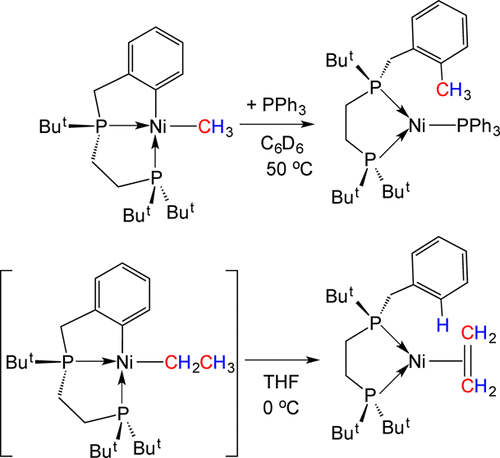当前位置:
X-MOL 学术
›
Organometallics
›
论文详情
Our official English website, www.x-mol.net, welcomes your feedback! (Note: you will need to create a separate account there.)
β-Hydrogen Elimination and Reductive Elimination from a κ3-PPC Nickel Complex
Organometallics ( IF 2.8 ) Pub Date : 2018-07-05 , DOI: 10.1021/acs.organomet.8b00297 Amanda C. Zimmerman 1 , Michael D. Fryzuk 1
Organometallics ( IF 2.8 ) Pub Date : 2018-07-05 , DOI: 10.1021/acs.organomet.8b00297 Amanda C. Zimmerman 1 , Michael D. Fryzuk 1
Affiliation

|
The incorporation of a PPC donor ligand set onto nickel is described. While C–H activation routes using Ni(II) precursors and benzyl- and phenethyl-substituted diphosphines But2PCH2CH2P(But)R failed, success was achieved via oxidative addition of the 2-bromo-benzyl-ligand precursor But2PCH2CH2P(But)(CH2-o-C6H4Br) with Ni(COD)2 to generate [κ3-BnPPC]NiBr. Subsequent reaction with KBEt3H resulted in decomposition unless PPh3 was present, which allowed isolation of the tricoordinate Ni(0) complex [κ2-BnPP]Ni(PPh3). Reaction of [κ3-BnPPC]NiBr with EtMgCl also resulted in the formation of the Ni(0) ethylene complex, [κ2-BnPP]Ni(η2-C2H4), via β-elimination followed by reductive elimination. Deuterium-labeling studies are consistent with a reversible β-elimination process prior to reductive elimination, which scrambles the deuterium isotopes. Reaction of [κ3-BnPPC]NiBr with CH3Li results in the formation of the Ni(II) methyl complex, [κ3-BnPPC]Ni(CH3). Heating this species in the presence of PPh3 results in the formation of the Ni(0) derivative, [κ2-Bn-o-MePP]Ni(PPh3), in which reductive elimination of the methyl and aryl units has occurred. Reaction of [κ3-BnPPC]NiBr with heteroatom-containing species such as sodium isopropoxide, sodium 2-propanethiolate, and lithium methylphenylamide resulted in different outcomes depending on the heteroatom; with isopropoxide, the products isolated were geometric isomers of Ni(0) η2-acetone adducts, which presumably arise via a β-elimination–reductive elimination sequence; the analogous sulfur reagent generated isolable Ni(II) isopropyl thiolate species that was resistant to β-elimination upon thermolysis; with methylphenylamide, the Ni(II) amido complex could be isolated and structurally characterized; subsequent heating to 80 °C resulted in β-elimination followed by reductive elimination to generate a Ni(0) phenylimine complex. While the κ3-PPC donor set generates stable Ni(II) derivatives, further functionalization at nickel with hydride, alkyl, and heteroatom-containing moieties can lead to Ni(0) products via a combination of β-elimination and/or reductive elimination.
中文翻译:

β氢消除和还原消除从κ 3 -PPC镍络合物
描述了将设置在镍上的PPC供体配体掺入。而用Ni CH激活途径(II)前体和苄基和苯乙基取代的二膦卜吨2 PCH 2 CH 2 P(卜吨)R失败,成功经氧化加成的2-溴-苄基配体的实现前体卜吨2 PCH 2 CH 2 P(卜吨)(CH 2 - ö -C 6 ħ 4溴)用Ni(COD)2以产生[κ 3 - BN PPC] NIBR。随后与KBEt 3的反应小时导致分解除非PPH 3存在,这使得三配位的Ni(0)络合物的隔离[κ 2 - BN PP]的Ni(PPH 3)。的反应[κ 3 - BN(0)乙烯络合物,[κNIBR与EtMgCl也导致Ni的形成PPC] 2 - BN PP]的Ni(η 2 -C 2 H ^ 4),通过β消去,然后还原消除。氘标记研究与还原消除之前可逆的β消除过程一致,该过程扰乱了氘的同位素。的反应[κ 3 - BN PPC] NIBR用CH 3李导致Ni的形成(II)甲基络合物,[κ 3 - BN PPC]的Ni(CH 3)。在PPH的存在下加热该物种3个中镍的形成结果(0)衍生物,[κ 2 - BN- ø -Me PP]的Ni(PPH 3),在其中发生了甲基和芳基单元的还原消除。[κ的反应3 - BN PPC]与含有杂原子的种类,例如异丙醇钠,2-丙硫醇,和锂methylphenylamide NIBR导致取决于杂原子不同的结果; 用异丙醇,分离出的产物为(0)的Ni的几何异构体η 2-丙酮加合物,大概是通过β-消除-还原消除序列产生的;类似的硫试剂产生可分离的Ni(II)异丙基硫醇盐,其在热解时具有抗β-消除作用;用甲基苯酰胺可以分离Ni(II)酰胺配合物并进行结构表征。随后加热到80°C,导致β-消除,然后还原消除,生成Ni(0)苯基亚胺配合物。而κ 3 -PPC供体组产生稳定的Ni(II)的衍生物,在与氢化,烷基镍进一步官能化,和含杂原子的基团可导致的Ni(0)经由β-消除和/或还原消除的组合产品。
更新日期:2018-07-08
中文翻译:

β氢消除和还原消除从κ 3 -PPC镍络合物
描述了将设置在镍上的PPC供体配体掺入。而用Ni CH激活途径(II)前体和苄基和苯乙基取代的二膦卜吨2 PCH 2 CH 2 P(卜吨)R失败,成功经氧化加成的2-溴-苄基配体的实现前体卜吨2 PCH 2 CH 2 P(卜吨)(CH 2 - ö -C 6 ħ 4溴)用Ni(COD)2以产生[κ 3 - BN PPC] NIBR。随后与KBEt 3的反应小时导致分解除非PPH 3存在,这使得三配位的Ni(0)络合物的隔离[κ 2 - BN PP]的Ni(PPH 3)。的反应[κ 3 - BN(0)乙烯络合物,[κNIBR与EtMgCl也导致Ni的形成PPC] 2 - BN PP]的Ni(η 2 -C 2 H ^ 4),通过β消去,然后还原消除。氘标记研究与还原消除之前可逆的β消除过程一致,该过程扰乱了氘的同位素。的反应[κ 3 - BN PPC] NIBR用CH 3李导致Ni的形成(II)甲基络合物,[κ 3 - BN PPC]的Ni(CH 3)。在PPH的存在下加热该物种3个中镍的形成结果(0)衍生物,[κ 2 - BN- ø -Me PP]的Ni(PPH 3),在其中发生了甲基和芳基单元的还原消除。[κ的反应3 - BN PPC]与含有杂原子的种类,例如异丙醇钠,2-丙硫醇,和锂methylphenylamide NIBR导致取决于杂原子不同的结果; 用异丙醇,分离出的产物为(0)的Ni的几何异构体η 2-丙酮加合物,大概是通过β-消除-还原消除序列产生的;类似的硫试剂产生可分离的Ni(II)异丙基硫醇盐,其在热解时具有抗β-消除作用;用甲基苯酰胺可以分离Ni(II)酰胺配合物并进行结构表征。随后加热到80°C,导致β-消除,然后还原消除,生成Ni(0)苯基亚胺配合物。而κ 3 -PPC供体组产生稳定的Ni(II)的衍生物,在与氢化,烷基镍进一步官能化,和含杂原子的基团可导致的Ni(0)经由β-消除和/或还原消除的组合产品。



























 京公网安备 11010802027423号
京公网安备 11010802027423号